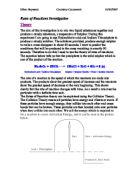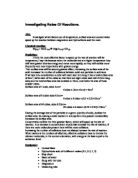Reaction forms
There are two distinctive different reaction types and they are endothermic and exothermic. An endothermic reaction is when energy is taken in from the surroundings, usually in the form of heat and generally shown by a temperature decrease. Endothermic reactions are not as frequent and are not easy to spot. An example of a reaction being endothermic is photosynthesis. An Exothermic reaction is when energy is given out to the surroundings, in the form of heat and shown by a temperature increase. The best example of an exothermic reaction is burning fuels, as it gives out a lot of heat.
There are four main factors that influence the rates of reaction:
Concentration: When increasing the concentration of a reactant it increases the number of molecules in a set amount. Therefore the concentration increases the number of collisions and this gives more chance of a collision.
Catalysts: A catalyst is a substance which increases the rate of reaction but not altered during the reaction. They work by offering an alternative way which requires lower activation energy.
Surface Area: When increasing the surface area of a solid in a reaction between a solid and either a liquid or a gas. This would result in an increased amount of collisions between them, therefore increasing the rate of reaction. The surface area though in this experiment does not apply.
Light: The light can change the experiment as it can alter the temperature with heat but in this experiment as the same as surface area, it does not apply.
Temperature: The rate of reaction increases with temperature. At a higher temperature particles will have more energy and so will move around more and faster and there will be more collisions.
Method
In this experiment there are a number of safety precautions I must take. To start with I am going to be dealing with acid which is a corrosive and if I got that on my hands I would wash them straight away, or if I was to spill any I would clean it up immediately. But the major precaution is to wear safety goggles and laboratory coats. Another precaution is that I will work in a well ventilated room because there is a gas given off, which is Sulphur Dioxide.
There are a few things I will be doing to make sure I have a fair investigation that I keep everything constant and the same:
- Use the same cross for each experiment
- The same hydrochloric acid volume
- The volume of the total solution at 55cm³
- To always use clean equipment
- Always keep the same temperature
- The same distance between my eye and flask when observing.
I will start the experiment by first applying the safety precautions, of goggles and lab coats. I will then take a piece of paper and label on it a cross marked by a waterproof black permanent marker, which will be kept for all experiments. I will gather three chronicle flasks, one to be placed on top of the piece of paper above the cross, and one either side of the paper with a measuring cylinder. The chronicle flask on one side will contain Sodium Thiosulphate and on the other side shall contain Hydrochloric Acid. For the first I will use 50cm³ of Thiosulphate, 5cm³ of Acid and no water. For all the investigation I am going to use 5cm³ of Hydrochloric acid and only change the amount of water and Thiosulphate levels. I am doing this so the acid is going to remain constant so my total volume remains at 55cm³.
To start the experiment I pour exactly 50cm³ of Thiosulphate into a measuring cylinder from the Thiosulphate chronicle flask. I pour 5cm³ of Acid into a measuring cylinder from the HCL chronicle flask, (and no water)
With the third chronicle flask sitting on the cross I pour both substances into the flask, swill round once and start the stop clock. With my safety goggles on from 20cm away approximately I watch the liquid change into a cloudy solution. When I can clearly not see the cross and has disappeared from visibility. I stop the clock and take the reading and put it into my results like the one that can be seen on the next page. The recorded times on the stop clock are to two decimal points. I am going to round up the figures to the nearest second because the reaction from my eye, not being able to see the cross to me stopping the clock will not be a correct, delaying the time.
I will repeat each experiment twice for each concentration and take the average from both runs therefore making it a fair test. Another thing to do to make sure it is a fair investigation is that I keep the total volume at 55cm³ throughout the whole investigation. From my results I can then plot graphs of Thiosulphate, Acid and Water all against the time to show the disappearance in 90 seconds.
Hypothesis
Having looked at my results I can say that I wasn’t that close to 90 which could be changed by changing the amount of Hydrochloric Acid, or maybe just watching more intensely. But as you can see the results are good because in my graphs 90 seconds can be seen by looking up to the curve then across to the y axis. Giving you are reading with Water, Thiosulphate and Hydrochloric Acid.
Results & Analysis
From these results which are accurate because of both runs are very much in common when repeated. They give me a good range for plotting graphs as I have 3 or 4 either side of ninety seconds. This means that when I come to my final answer of how long it takes for the cross to disappear in 90 seconds my answer will be read off accurately. The results show consistency the whole way through the investigation as I have kept it a fair test, keeping the total volume 55cm³ right the way through.
It is interesting because my results have made all the graphs much different from one and other as you can see behind this page. The Hydrochloric Acid graph (labelled 2) travel in a straight line as I kept it at 5cm³ all the time during the experiment. The Sodium Thiosulphate graph (labelled 1) and water graph (labelled 3) are more curvaceous, but the opposite to one and other.
From the results I have gathered I can work out the final concentration and compare it to the concentration I get from the graphs. Using the information that Concentration is the wrong way round compared to time I can work out the required concentration.
Conclusion
Evaluation
This experiment is fairly difficult as there is a lot of judgement on human senses that can not always be trusted. If I was to repeat this experiment I would use a light gate to measure the cloudy precipitate as this would eliminate human error from the eye and delay on the retina, and I would also use a magnetic stirrer so that I could be absolutely certain that the solution was sufficiently mixed.
My results appear fairly accurate although looking at the tables of raw data one might say that there are a couple of anomaly. However, I feel that I have eradicate these by repeating the experiments and taking the mean.
If I had more time I would further my experiment to investigate the ways in which the different factors, such as temperature and surface area,would affect the Rate of Reaction for this equation, and discover how the different rates compare.







